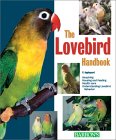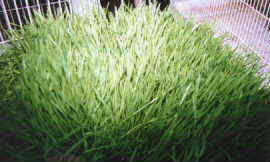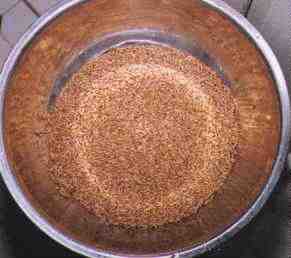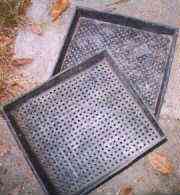Wheatgrass: Health Food for Pet Birds
Wheatgrass Can Improve the Health, Vitality, and Fertility of Your Companion and Breeder Birds
Wheatgrass juice revitalizes and energizes humans, and it can do the same for companion birds. While humans must use a special press to extract the juice from wheatgrass, parrots have a built-in juice extractor: their beaks. They squeeze the delicious, nutritious juice from each blade, then discard the indigestible portion.
Why Wheatgrass Is So Special and How to Grow Wheatgrass At Home
Chlorophyll, the life-blood of plants, is the main ingredient in wheatgrass. Chlorophyll cleanses the blood by improving the supply of oxygen to the circulatory system. It detoxifies and regenerates the liver, making this an especially good food stuff for birds with fatty liver syndrome. Chlorophyll protects us from carcinogens in our food and in our air. It can actually neutralize some pollutants, according to Japanese scientists, including the pollutants found in car exhaust!! If you live in a car-congested city, you MUST drink wheatgrass juice, as must your birds. Dr. Chiu-Nan Lai of the University of Texas has demonstrated many of the anti-mutagenic effects of wheatgrass juice. Do not go out and buy liquid chlorophyll and add it to your or your birds’ diet. Much of the scientific literature suggests that it is not just the chlorophyll that has beneficial effects, but the plant as a whole. The complexity of plantlife can make it difficult to separate out what is having the direct effect, although some studies have shown a direct effect of chlorophyllin, the sodium and copper salt of chlorophyll a.
[NB: Both antimutagenic effects and anti-genotoxic activity of common dietary phytochemicals have been shown in vertebrate animals. It reduced the carcinogenic uptake of the environmental carcinogen dibenzo[a,l]pyrene (DBP) in a controlled study of rainbow trout (Carcinogenesis, July 1998).]
Enzymes determine the efficiency and health of the metabolic system. They break down the nutrients in food so they can be used by the body and they are behind most of the chemical processes that sustain life, affecting everything from digestion to healing. The naturally occurring enzymes in our bodies can be aided and benefitted by the addition of enzymes in the diet. The most natural enzymes come from live food, such as wheatgrass, that has not been changed through processes such as preserving and cooking. Fresh wheatgrass is highly preferable over powdered wheatgrass.
Liquid Oxygen: sounds good, doesn’t it? Wheatgrass has been shown to expand the blood vessels and improve circulation; this improves oxygenation of blood and the ability to rid the blood of toxins. The need to improve oxygenation of the blood has been emphasized again and again in human nutrition. It applies to birds as well. B12, Iron, Folic Acid, Minerals…the list goes on. Wheatgrass contains all these nutrients and more. Wheatgrass juice has been successfully used to treat anemia in humans.
Repair the Liver: choline, magnesium, and potassium work together to detoxify and regenerate the liver. Liver disease remains a major problem in companion birds, due many times to over reliance on a high-fat, seed-based diet. Wheatgrass can be invaluable while trying to get an overweight bird back in shape; it can change the color of blood and the color of the liver to a healthy red. It is powerful stuff.
DNA: The building blocks of life! Some studies out of UC, San Diego, have shown remarkable changes in damaged DNA upon the introduction of a compound found in young grasses like wheatgrass. These studies were done on reproductive cells, and the results suggest that wheatgrass may improve fertility and even restore fertility. Yes, restore fertility (this study was done on bulls).
Vitamins that occur naturally in foods are far superior to those found in synthetic supplements. Doesn’t this simply make sense? If you’re putting powered, lifeless vitamins on your birds’ food stuffs, you are probably creating a false sense of security. Natural is better. Wheatgrass contains as much Vitamin A as carrots, as much Vitamin C as citrus fruits, and ample supplies of Vitamin E and B complex vitamins. Vitamins in this natural, raw state are so superior to synthetic vitamins that it is pure madness to choose the latter over the former. We as a society have become far too dependent on synthetic supplements. I am always shocked when skeptics decry the claims about fresh, live foods but then put powdered vitamins in their water bowls. In my opinion, many are victims of consumerism. They believe that paying $20 for a bottle of powdered vitamins is more useful than a $2 flat of wheatgrass. Let’s get back to nature–our companion birds deserve it.
Can You Believe It? Calcium Too!!! It can be difficult to regulate calcium levels, particularly in breeding birds. Wheatgrass is an excellent source of calcium and it has other minerals that are necessary for the body to use it. Calcium given alone has long been problematic. Wheatgrass has potassium, which is an essential ingredient in metabolizing calcium.
Amino Acids are the building blocks of protein. A lack of proper amounts of amino acids in our food can lead to allergies (anyone with birds who have skin allergies, feather-plucking problems?) , poor/slowed healing, poor digestion, poor immunity against bacteria and diseases. Anyone having problems with recurring bacterial infections in their birds should try fresh wheatgrass! I have had NO bacterial infections and NO loss of babies since I started using it. Amino acids like valine control the ability to deal with stress: it literally calms the nerves.
Price that can’t be beat. Believe me, wheatgrass not only nutritionally beats processed superfood supplements like Chlorella (hard to digest), blue green algae (hard to control quality), and spirulina (like Chlorella, it loses much of its nutritional value during the extraction, preparation, and packaging process), but it also beats these supplements hands-down in price. Even if you don’t grow the wheatgrass yourself, most good Farmers’ markets will sell flats for as little as $6.00. To give you an idea of how far this will go, I can feed with one flat: 30 lovebirds, 20 budgies, 1 blue front amazon, 1 Senegal, 1 green-cheek conure, and a handful of finches and canaries. If you grow the wheat grass yourself, the cost will be around $2.00 a flat.
How to Grow Wheatgrass
The whole process from sprouting to harvesting takes about a week. First, you need to buy some winter wheat berries (or hard wheat berries), preferably organic! Go to any good health food store with bulk supplies. They are a reddish, hard grain.
Rinse the wheat berries then place them in a wide-mouth jar or a bowl and cover them with water. Cover the bowl with a towel or cheesecloth and let sit overnight (12 hours). Rinse the wheat berries then let them remain damp (a wet paper towel on top of them can help) for the next 12 hours. Rinse them at least once during this period. If it is very hot and therefore bacterial growth is a concern, add a drop of bleach to the water you originally soak the wheat berries in (1 tsp bleach per gallon of water is a general guideline).
After this 24 hour period you will see that the wheat berries have begun to sprout. Now you’ll want to “plant” your wheat berries. I use special flats to do this. They are plastic square containers with small holes for drainage. Most good nurseries can supply you with one. You can also use plastic cafeteria trays or pie pans, but the container should be very shallow, and it is best if you can add some small drainage holes. Add about 1 inch of soil (a 50:50 mixture of top soil and peat moss is best) and make it flat and even. Add your sprouted wheat berries and spread them into a flat, single layer. Sprinkle a tiny bit of water (don’t over water or you’ll get moldy seeds!). You can either cover this tray or place the tray in a dark closet (this mimics the period in nature when the seed is under the ground).
After about two days the seeds will have hearty stalks of grass sprouting from them. You can now let them be exposed to the sun (but make sure it has shade).
Water the flat then let it grow for another 4 or 5 days. Voila! Fresh wheatgrass for a handful of change (1 lb of berries is about 80¢ and makes a flat).
Cut the grass with scissors and feed it to your birds.
You should start another flat right away, since wheatgrass is best on its first growth so should not be used again. You can use the second-growth grass as compost (some people do use the second growth, then compost the remainder).
Feeding Wheatgrass
Like all things, don’t go overboard. Wheatgrass is high in iron so you don’t want to overload your birds’ diet with it. Three to four times a week is sufficient, and just a handful of grass is enough each time. Cut the grass about an inch up from the seed and serve. There is no need to worry about the grass spoiling in the cage, another great benefit of this green food. If you are concerned about bacteria or mold at the base of the grass, after cutting, soak the grass in a quart of water with 5 drops of grapefruit seed extract for 5 minutes, rinse thoroughly, then serve.
Troubleshooting
My wheat berries won’t sprout, or only a few sprout.
The problem could be old, “dead” seeds that have been sitting on a grocery store shelf for to long. Try to buy at health food stores that supply bulk seeds and grains and refresh their supplies on a regular basis.
My wheatgrass has some moldy areas around the roots.
The problem could be overwatering. Water only enough to give moisture, not so that mold can grow. If you are worried about mold and bacteria that you cannot see, cut the grass about 1 inch up from the seed/roots; soak the grass in a solution of water and 5-10 drops of grapefruit seed extract for 5 minutes. Rinse the grass thoroughly, then serve.
My wheatgrass is limp and droopy.
The problem could be too much sun. Wheatgrass grows best in indirect light, under the shade of a tree or the like.
A special note for skeptics and those who dismiss anything that does not come encased in a gelatin capsule or does not require a medical prescription…
Who has studied the effects of young grasses in vivo or in vitro? Yoshide Hagiwara, MD; Tsuneo Kada (Japan Research Center of Genetics); Dr. Chiu-Nan Lai (University of Texas); Dr. Arthur Robinson (Linus Pauling Institute); Dr. Thelma Arthur (Arthur Testing Laboratory); Dr. Yasuo Hotta (University of California, San Diego). This is only a partial listing of scientists studying the effects of young grasses. Below are references from the world biomedical literature (much of it from peer-reviewed medical journals) on the effects of phytochemicals and chlorophyll-related compounds.
Remember, wheatgrass is not a drug or herb. It is a living food. By harvesting and juicing the grass, then drinking it immediately, you are ingesting a very live, nutritious green juice. The American Cancer Society and the National Institute of Cancer advice all of us to increase the number of green vegetables in our diet. One ounce of wheatgrass juice can make a significant difference in your diet. It is accepted fact that green foods are nutritious and have both antimutagenic and antigenotoxic benefits. The nutritional analysis of wheatgrass is scientific fact. Put two and two together, and it is not difficult to see why this is such a beneficial food for your diet as well as your birds.
Much of this information I learned from a grower at my Farmers’ Market and from the bible of wheatgrass: “The Wheatgrass Book” by Ann Wigmore, which is available in the Parrot-Parrot Book Store and contains much more detailed information; it is a must in any sprouter’s library!
References from the world scientific literature on chlorophyll-containing foods:
Dashwood R; Negishi T; Hayatsu H; Breinholt V; Hendricks J; Bailey G. Chemopreventive properties of chlorophylls towards aflatoxin B1: a review of the antimutagenicity and anticarcinogenicity data in rainbow trout. Department of Environmental Biochemistry, University of Hawaii, Honolulu 96822, USA. Mutat Res, 1998 Mar, 399:2, 245-53
Harttig U; Bailey GS. Chemoprotection by natural chlorophylls in vivo: inhibition of dibenzo[a,l]pyrene-DNA adducts in rainbow trout liver. Department of Environmental and Molecular Toxicology, and Marine/Freshwater Biomedical Sciences Center, Oregon State University, Corvallis 97331, USA. harttigu@bcc.orst.edu Carcinogenesis, 1998 Jul, 19:7, 1323-6
Higashi Okai K; Okai Y. Potent suppressive activity of chlorophyll a and b from green tea (Camellia sinensis) against tumor promotion in mouse skin. Department of Human Life Science, Osaka Kun-Ei Women’s College, Japan.
Sangyo Ika Daigaku Zasshi, 1998 Sep, 20:3, 181-8
Negishi T; Rai H; Hayatsu H. Antigenotoxic activity of natural chlorophylls. Faculty of Pharmaceutical Sciences, Okayama University, Japan. Mutat Res, 1997 May, 376:1-2, 97-100
Okai Y; Higashi Okai K; Yano Y; Otani S. Suppressive effects of chlorophyllin on mutagen-induced umu C gene expression in Salmonella typhimurium (TA 1535/pSK 1002) and tumor promoter-dependent ornithine decarboxylase induction in BALB/c 3T3 fibroblast cells. Division of Food and Nutrition, Osaka Kun-ei Women’s College, Japan. Mutat Res, 1996 Aug, 370:1, 11-7
Sarkar D; Sharma A; Talukder G. Clastogenic activity of pure chlorophyll and anticlastogenic effects of equivalent amounts of crude extract of Indian spinach leaf and chlorophyllin following dietary supplementation to mice. Department of Botany, University of Calcutta, India. Environ Mol Mutagen, 1996, 28:2, 121-6
Sarkar D; Sharma A; Talukder G. Chlorophyll and chromosome breakage. Department of Botany, University of Calcutta, India. Mutat Res, 1996 Aug, 360:3, 187-91
Tang X; Edenharder R. Inhibition of the mutagenicity of 2-nitrofluorene, 3-nitrofluoranthene and 1-nitropyrene by vitamins, porphyrins and related compounds, and vegetable and fruit juices and solvent extracts. Department of Hygiene and Environmental Medicine, University of Mainz, Germany. Food Chem Toxicol, 1997 Mar, 35:3-4, 373-8
Umemura K; Yumita N; Nishigaki R; Umemura S. Sonodynamically induced antitumor effect of pheophorbide a.
School of Pharmaceutical Sciences, Toho University, Chiba, Japan. Cancer Lett, 1996 Apr, 102:1-2, 151-7
Waladkhani AR; Clemens MR. Effect of dietary phytochemicals on cancer development (review). Medizinische Abteilung I, Krankenanstalt Mutterhaus der BorromÂaerinnen, 54219 Trier, Germany. Int J Mol Med, 1998 Apr, 1:4, 747-53












